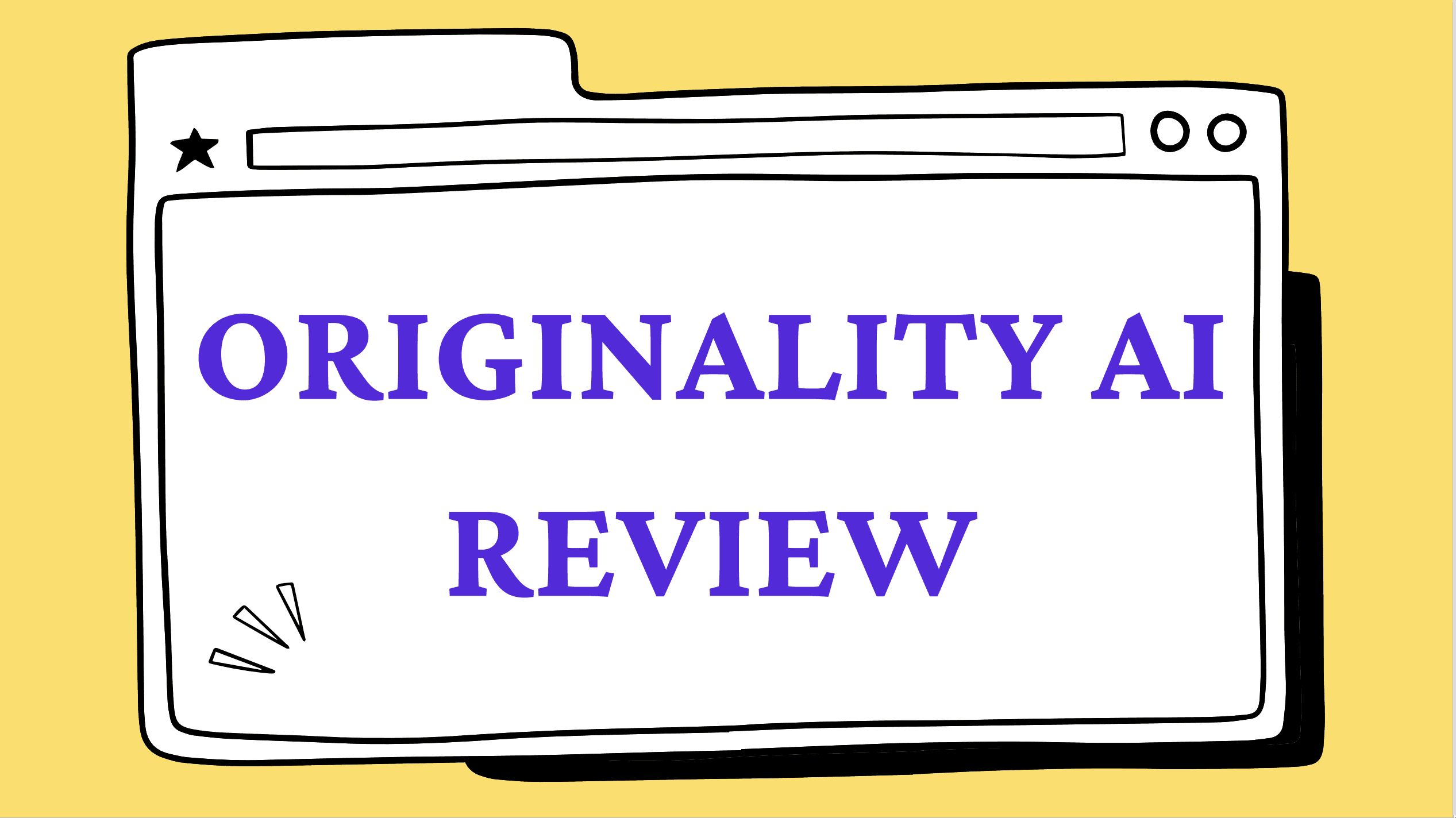In this blog post, I’ll give you my comprehensive Originality AI review.
Originality.ai is a program that checks whether a piece of text is, well original. It takes text as input and does two things —
- Tests whether it was written by any AI tool such as ChatGPT
- Checks this text for plagiarism
Originality AI uses its own trained model to predict the likelihood of a text being generated by AI, such as GPT-3, GPT-2, GPT-NEO, or GPT-J. It also checks for plagiarism by comparing the text to billions of academic sources and web pages. Then, it gives you a confidence score between 0 and 100 which shows how unique and human-like the text is.
Why does this tool matter?
Well, if you are a web publisher, a content creator, a student, a teacher, or anyone else who works with text, you probably want to make sure that your content is unique, high-quality, and real. You don’t want to put your reputation, credibility, and SEO at risk by publishing or submitting content that is copied or spun by AI.
Originality AI can help you avoid these problems by scanning your text and telling you how original it is.
In this blog post, I’ll explain how Originality.AI works, what its features and benefits are, and how it compares to other tools on the market that do similar things. I will also share with you my personal experience of using Originality AI for detecting AI-generated and plagiarized content.
Let’s jump right into it.
Originality AI Review
Rating: ⭐⭐⭐⭐½
If you are in a hurry, below are the key takeaways. For a detailed review, keep scrolling.
🚀 Positives
✅ Works exceptionally on content written using OpenAI’s language models such as ChatGPT, GPT-3, GPT-2, and so on.
✅ Saves all past scans
✅ Ridiculously cheap
✅ Zero learning curve
🔴 Negatives
👉 Works only on GPT-based language models such as GPT-3, GPT-2, GPT-J, etc. Doesn’t detect content written using other language models such as T-5, Bloom, etc.
👉 The UI could have been better.
Click here to buy Originality AI credits
Originality AI Review: Interface
This is what originality.ai’s dashboard looks like —
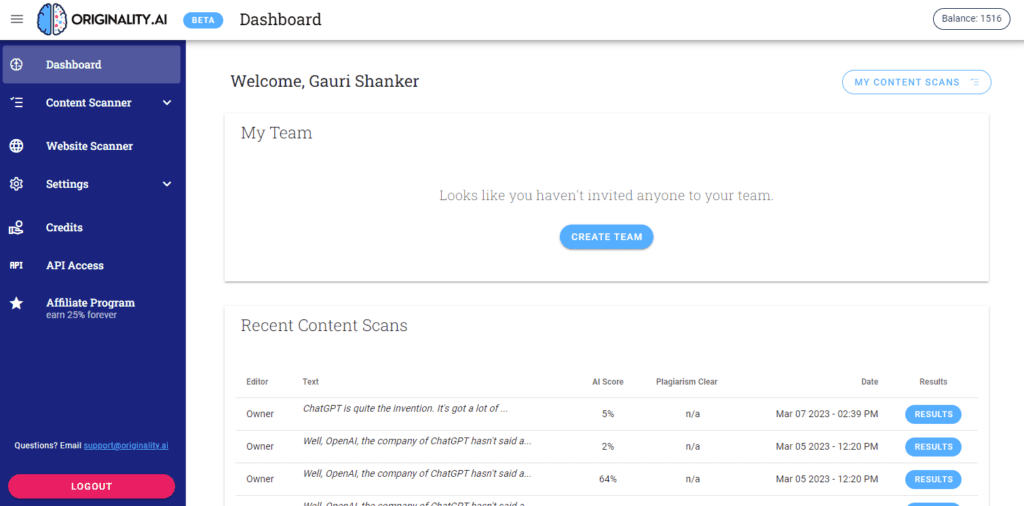
It is a tad clunky for my taste.
You are presented with a lot of information and UI elements that might confuse some people. There’s no button on the dashboard to scan a new text. You will have to click the ‘content scanner’ button on the sidebar to initiate a new scan.
The ideal interface (for the homepage) would have been just a big giant box, two checkboxes, and one button. All other options should have been tucked away either in a collapsed menu icon (☰) or in light grey color at the bottom footer to keep it minimal.
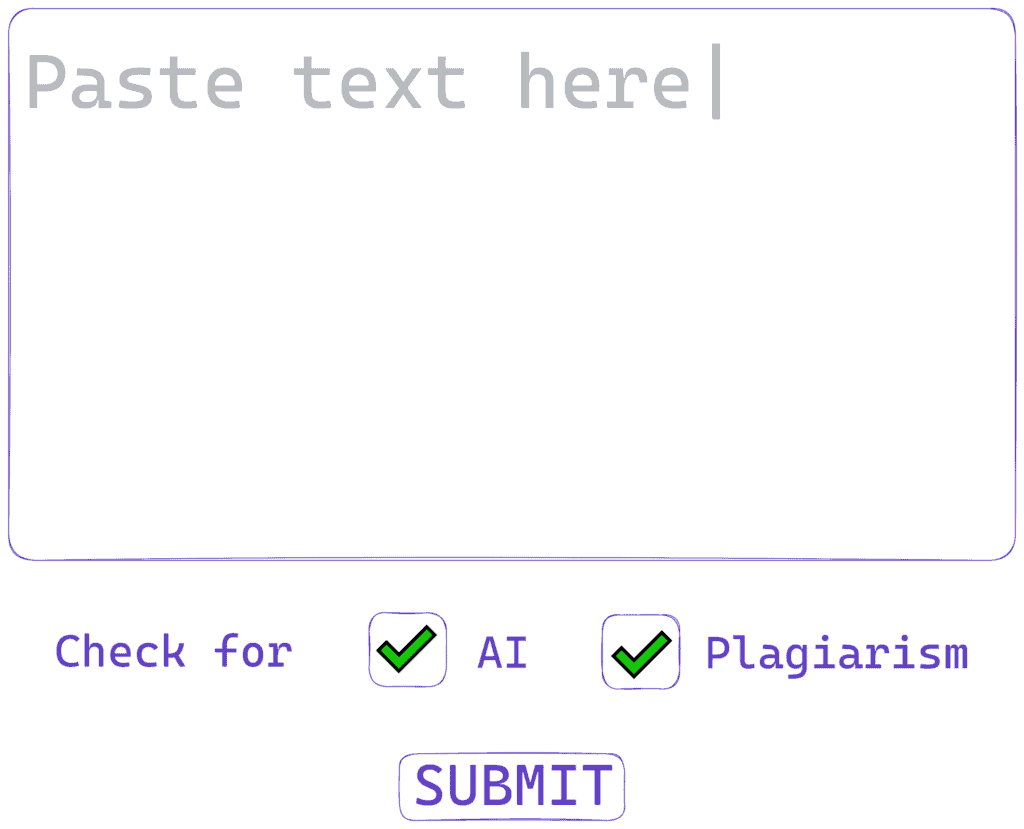
Nevertheless, once you get past the dashboard, things are simple and incredibly easy to use. Clicking the “start new scan” button in the content scanner will bring you to this screen:
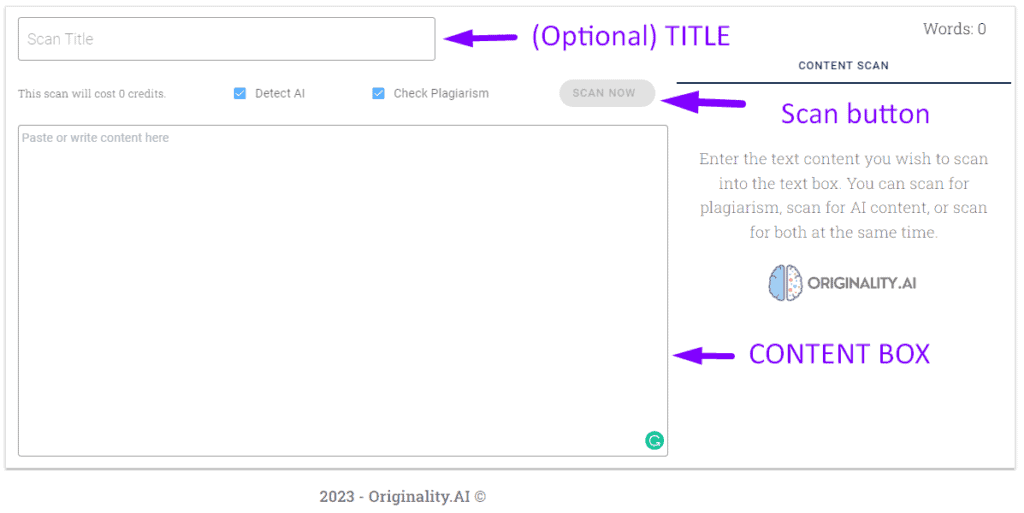
You have a giant text box to paste your content into and an (optional) title box where you can give your text a title to make it easy to recognize later. You also have two checkboxes, one for AI detection, and one for plagiarism. On the right side, you can see the number of words that your target content has.
Once you paste your content, it also shows how much of your credits will be consumed in running this scan. I will talk about its credit system later in the article.
All your scans are automatically saved which you can revisit by clicking the “My content scans” in the sidebar.
Now let’s get into the meat of the program.
Originality AI Review: Features
Let’s discuss whether the features advertised by Originality AI live up to the hype.
AI detection
Both, Originality AI and ChatGPT rely on the same technology to work.
ChatGPT uses formulas of probability and statistics to figure out how likely a word is to come up next based on what words have already come. It works kind of like autosuggest on your phone except that autosuggest is fairly limited in its capabilities.
See what happens when I ask ChatGPT to predict the next word in this sentence: “I worked hard all day. I was feeling ___________”, this was its response:

It knew that “exhausted” was the most likely candidate because in its training data, the word (or token in NLP) that most followed “work hard” was ‘exhausted’.
So, it shouldn’t be a surprise that the AI’s text predictions will be more accurate the more data it has to learn from, and that’s where language models come in.
ChatGPT uses GPT-3.5 which is the successor to the largest language model GPT-3 which had 175 billion parameters and required 800 GB to store.
There are numerous language models such as GPT-2, GPT-J, GPT-Neo, Bloom, T-5, Neo X, Google’s LaMDA, and so on.
Originality AI has been trained on GPT-based models such as GPT-3, GPT-2, GPT-J, and GPT-Neo, so it can almost always tell when a piece of content has been written by ChatGPT (or any of the GPT-based AI tools).
Think of it like this: if a student writes an essay from a book that the teacher has also read (and remembers), he will most certainly be caught.
AI detection: Actual results
Now that you know how AI detection works, let’s see if Originality AI does what it’s supposed to do.
Originality.ai claims on its website that it successfully detects about 94% of the content generated by ChatGPT, GPT-3, GPT-2, GPT-Neo, and GPT-J language models.
I did my own case study and found that their claim was partially true. I generated 10 blog posts using ChatGPT and tested them with originality.ai for AI and plagiarism. You can read the details of this case study in this article.
Originality AI flagged 7 posts as having 98% AI and the remaining 3 as having less than 30% AI. The average AI score of all 10 blog posts was 74.2%, which is pretty impressive given that OpenAI’s own AI detector also gave very similar results.
One good thing about originality AI is that it also highlights the text that it thinks is not original. A dark red highlight is a strong sign that it was written by AI, while a dark green highlight indicates that it was likely written by a human.
This is very useful because you can edit your text right in Originality AI’s textbox until you get a green signal.
AI detection of paraphrased text
One thing that’s become popular in the community is using paraphrasing tools like Quillbot to outsmart AI detectors.
It is believed that AI detection tools look for particular patterns in a text when they test it for AI, so Originality.ai surprised me when it claimed that its tool can even detect paraphrased AI content.
In my tests, however, it failed miserably. It gave less than a 10% AI score to 9 out of 10 paraphrased blog posts while the remaining one scored just 19% AI.
However, in my day-to-day workflow, I observed that it works slightly better on shorter paraphrased content. Whenever I paraphrased about 100 words and fed them to Originality, it flagged them for AI content more often than not.
Plagiarism
I have tested over 50 different blog posts written by AI programs such as ChatGPT, Jasper AI, WriteSonic, and Bing Chat but never has it once flagged any of them for plagiarism.
That’s not to say that Originality AI doesn’t work. In fact, AI tools like ChatGPT are built and trained in a manner that they don’t copy content from a single source word for word. Instead, they are taught to think in “tokens,” instead of sentences. They figure out how likely it is that one token will come after another, pick the one with the highest chance, and chain them together.
Therefore, it doesn’t often happen that an AI tool worth its salt produces plagiarised content.
To test Originality’s plagiarism detector, I had to manually copy some text from different blog posts available online. Originality AI was able to detect plagiarised text most of the time but sometimes it missed. A few times, it flagged only 50 to 60% of the content as plagiarised.
I also wanted to see if it could detect plagiarism from newer, less well-known blogs. I copied a piece of text from my other blog and tested it for plagiarism. I was surprised to find that Originality AI flagged that too. It even gave me a link to my article from where it was copied.
This is impressive because that blog is not even 6 months old and gets only about 100 pageviews a month.
Chrome extension
Originality AI also has a Chrome extension that, when installed, floats to the right of your browser window. One click and it slides in from the sidebar to reveal a giant text box to paste your text into.
This is particularly useful if you have a lot of content to test for AI and plagiarism. You don’t have to leave your tab, you can do everything right from where you are in the browser.
Website Scanner
If you want to buy a new website, you should probably run its content through Originality AI to see if there are any signs of plagiarism or AI.
Originality AI’s website scanner can scan up to 1000 webpages, and it works fast too. I ran my old blog through it, which had seven pages (~9,000 words). It scanned it in a few seconds and gave me the results in a table.
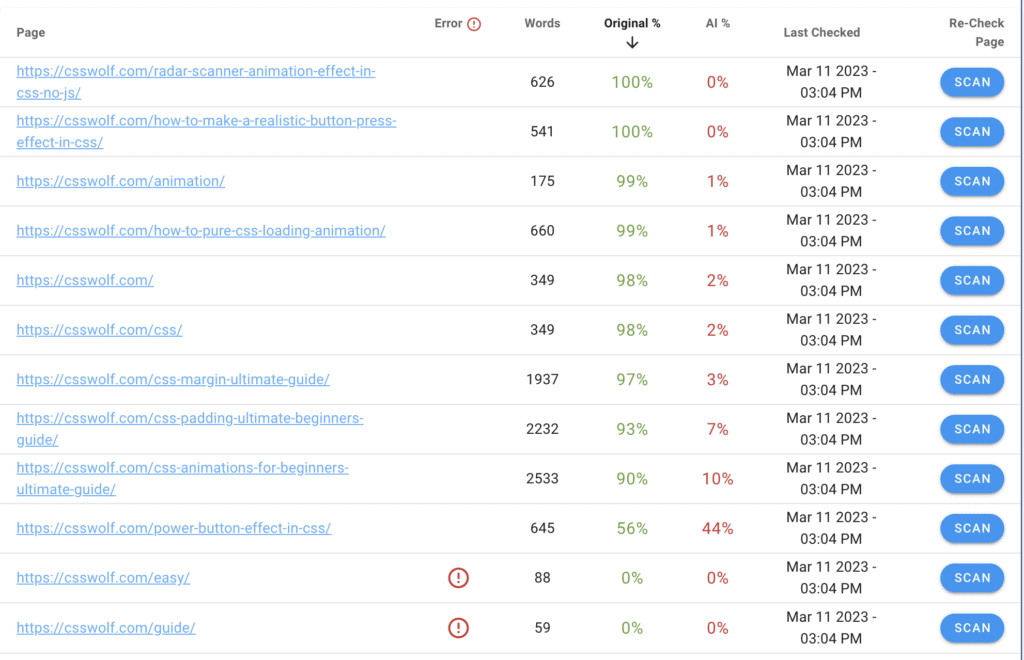
Add team members
You can share your credits with your team members. You can add them to your account via their email. You can also assign them permissions for what tasks they can perform with this account.
This feature is important because you can save money and time by using the same account for multiple projects and tasks. You can also work more easily and effectively with your team since everyone will have access to the same tools and data.
Originality AI Review: Limitations
Doesn’t detect content from other language models
Originality AI’s biggest flaw is probably that it doesn’t work on AI that it hasn’t been trained on.
For example, I did a case study in which I used Jasper AI to write 49 blog posts and then used Originality AI to test them for AI detection. Originality AI did a terrible job there because Jasper gets its data from more than just the GPT-3.5 language model.
This makes sense since every piece of text made by a computer has its “watermark.” The language model’s quirks are baked into the text that it generates. For each language model, things like word choice, sentence structure, data, the length of the text, and the length of each paragraph are different.
So, an AI tool that has been trained on one language model won’t reliably flag AI text from another language model.
Easy to fool
Another drawback of Originality AI is that it is very easy to fool. If you make a typo or forget to put in a comma or put it in the wrong place, the AI score falls drastically.
I tested it with a piece of 100% AI content that it (correctly) flagged as 100% AI-generated. When I put a comma after a word, the AI score dropped to 99%. Another comma after another word and the AI score came down to 63%. With a third comma, it went down to 53%.
It is, however, important to note that this happens with all AI-detection tools, even with OpenAI’s own program, so we can’t really fault Originality AI for that.
Also, I don’t think that Google will be fooled so easily. If tiny fledgling companies like Originality AI and Jasper can get licenses from OpenAI, Google most certainly can. Google even has its own language model LaMDA, which might prove a tough competitor to ChatGPT.
Whatever Google rolls out or bakes into its algorithm, it will be a mightier, beefier version of Originality AI.
Pricing: is it worth it?
To use Originality AI, you have to buy credits (1 credit for $ 0.01) and one credit scans 100 words. The minimum credits you can buy are 2,000. So, you will have to spend $20 minimum.
One credit for 100 words translates to just $1 for 10,000 words, which is a crazy low price for what it does. Another good thing about it is that it is not a monthly subscription. You pay only for what you use.
Think about it this way: if you write 10 blog posts of 1500 words each every month, it will only cost you $1.5 to find out if your content is original or copied.
How credits in Originality AI work
The number of credits is calculated by rounding the total number of words to the nearest 100. A text with 330 words will cost 3 credits, while a text with 370 words will cost 4 credits.
Also, if you run tests for both AI and plagiarism, your credits will be used up twice as quickly.
You can scan a minimum of 50 words.
Comparison with Writer.com
Writer.com is an AI writing service that offers a free AI detection tool that works for up to 1500 characters (~280 words) at a time. You cannot extend this limit, even if you are a paying customer of Writer.com.
In my testing, I found that it doesn’t work as well as Originality AI.
It gave an average AI score of 44.8% to the 10 blog posts I had ChatGPT write, compared to 73.2% by Originality AI.
You can read the results of the case study here.
Should you buy it?
If you don’t have to please Google, or if you don’t use AI at all, you absolutely don’t need this. If you need to check for AI content only very occasionally, you can probably get by with Writer.com’s free AI detection tool.
But, if you are a blogger or are using AI content writing tools heavily, you cannot afford to miss this.
The one thing that sets Originality AI apart is its surprising accuracy with which it detects GPT-based content. This is significant because most of the AI content you are likely to encounter is going to be GPT based.
This is because GPT-3.5 is the largest model which produces human-like text with surprising accuracy. This is one reason why so many AI writer tools like WriteSonic, Jasper, etc use GPT-3.5 to source their data.
So, no matter which AI tool you use to write content, Originality can work to make sure you don’t accidentally publish a piece of text online with a distinguishable AI watermark in it.
Also, if you depend on any external agency for your writing needs, then you definitely need this. You cannot afford to publish a piece of content online which might be flagged as AI or plagiarised. With a tool as cheap as Originality ai, it will pay to be on the safer side of Google.
Buy Originality AI credits here.
That’s all from my side guys, I hope this article helped you make an informed decision. Thanks for reading.
